Pumping Station Desing - Second Edition by Robert L. Sanks, George Tchobahoglous, Garr M. Jones
Подождите немного. Документ загружается.

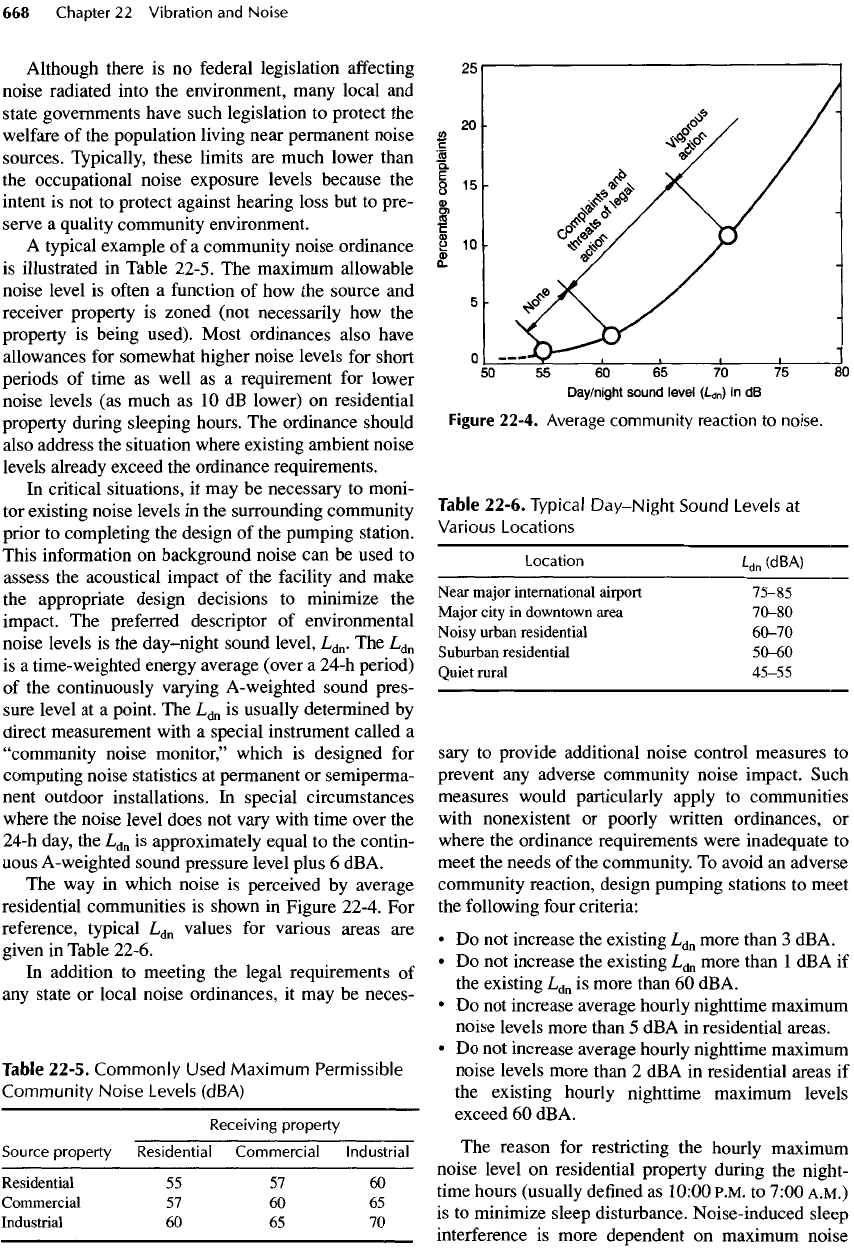
Although
there
is no
federal legislation
affecting
noise radiated into
the
environment, many local
and
state governments have such legislation
to
protect
the
welfare
of the
population living near permanent noise
sources. Typically, these limits
are
much lower than
the
occupational noise exposure levels because
the
intent
is not to
protect against hearing loss
but to
pre-
serve
a
quality community environment.
A
typical example
of a
community noise ordinance
is
illustrated
in
Table 22-5.
The
maximum allowable
noise level
is
often
a
function
of how the
source
and
receiver property
is
zoned (not necessarily
how the
property
is
being used). Most ordinances also have
allowances
for
somewhat higher noise levels
for
short
periods
of
time
as
well
as a
requirement
for
lower
noise levels
(as
much
as 10 dB
lower)
on
residential
property during sleeping hours.
The
ordinance should
also address
the
situation where existing ambient noise
levels
already exceed
the
ordinance requirements.
In
critical situations,
it may be
necessary
to
moni-
tor
existing noise levels
in the
surrounding community
prior
to
completing
the
design
of the
pumping station.
This information
on
background noise
can be
used
to
assess
the
acoustical impact
of the
facility
and
make
the
appropriate design decisions
to
minimize
the
impact.
The
preferred descriptor
of
environmental
noise levels
is the
day-night
sound level,
L
dn
.
The
L
dn
is
a
time-weighted energy average (over
a
24-h
period)
of
the
continuously varying
A-
weighted
sound pres-
sure
level
at a
point.
The
L
dn
is
usually determined
by
direct measurement with
a
special
instrument
called
a
"community
noise monitor," which
is
designed
for
computing
noise statistics
at
permanent
or
semiperma-
nent
outdoor installations.
In
special circumstances
where
the
noise level does
not
vary
with
time over
the
24-h day,
the
L
dn
is
approximately equal
to the
contin-
uous
A-
weighted
sound pressure level plus
6
dBA.
The way in
which noise
is
perceived
by
average
residential communities
is
shown
in
Figure 22-4.
For
reference,
typical
L
dn
values
for
various areas
are
given
in
Table 22-6.
In
addition
to
meeting
the
legal requirements
of
any
state
or
local noise ordinances,
it may be
neces-
Table
22-5.
Commonly
Used
Maximum Permissible
Community
Noise
Levels (dBA)
Receiving
property
Source property
Residential
Commercial
Industrial
Residential
55 57 60
Commercial
57 60 65
Industrial
60 65 70
Figure
22-4.
Average
community
reaction
to
noise,
Table
22-6.
Typical
Day-Night
Sound
Levels
at
Various Locations
Location
L
dn
(dBA)
Near major international airport
75-85
Major
city
in
downtown area
70-80
Noisy urban residential
60-70
Suburban residential
50-60
Quiet rural
45-55
sary
to
provide additional noise control measures
to
prevent
any
adverse community noise impact. Such
measures would particularly apply
to
communities
with
nonexistent
or
poorly written ordinances,
or
where
the
ordinance requirements were inadequate
to
meet
the
needs
of the
community.
To
avoid
an
adverse
community
reaction, design pumping stations
to
meet
the
following
four
criteria:
• Do not
increase
the
existing
L
dn
more than
3
dBA.
• Do not
increase
the
existing
L
dn
more than
1 dBA if
the
existing
L
dn
is
more than
60
dBA.
• Do not
increase average hourly nighttime maximum
noise levels more than
5 dBA in
residential areas.
• Do not
increase average hourly nighttime maximum
noise levels more than
2 dBA in
residential areas
if
the
existing hourly nighttime maximum levels
exceed
60
dBA.
The
reason
for
restricting
the
hourly
maximum
noise level
on
residential property during
the
night-
time hours (usually defined
as
10:00
P.M.
to
7:00
A.M.)
is
to
minimize sleep disturbance. Noise-induced sleep
interference
is
more dependent
on
maximum noise
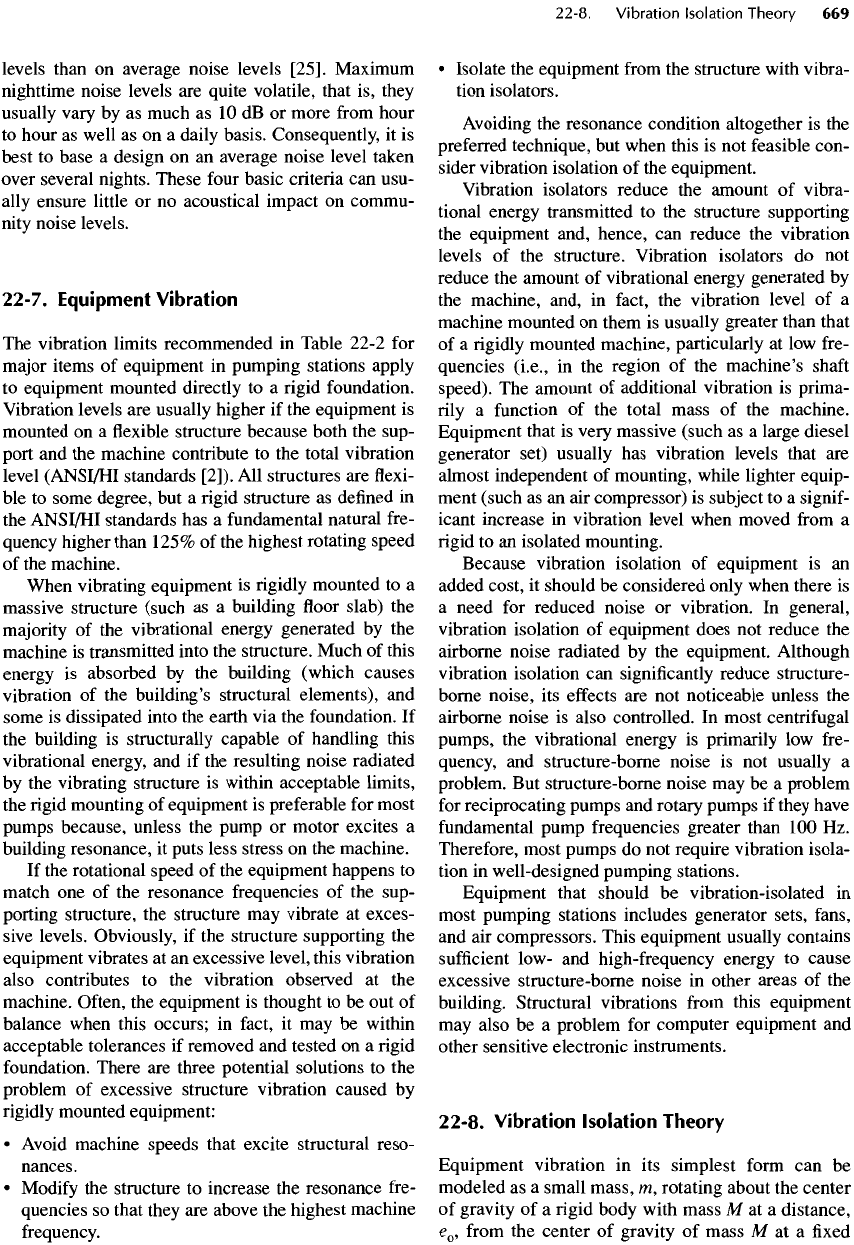
levels than
on
average noise levels
[25].
Maximum
nighttime
noise levels
are
quite volatile, that
is,
they
usually
vary
by as
much
as 10 dB or
more
from
hour
to
hour
as
well
as on a
daily basis. Consequently,
it is
best
to
base
a
design
on an
average noise level taken
over several nights. These
four
basic criteria
can
usu-
ally
ensure little
or no
acoustical impact
on
commu-
nity
noise levels.
22-7.
Equipment
Vibration
The
vibration limits recommended
in
Table 22-2
for
major
items
of
equipment
in
pumping stations apply
to
equipment mounted directly
to a
rigid foundation.
Vibration
levels
are
usually higher
if the
equipment
is
mounted
on a
flexible
structure because both
the
sup-
port
and the
machine contribute
to the
total vibration
level
(ANSI/HI
standards
[2]).
All
structures
are
flexi-
ble to
some
degree,
but a
rigid structure
as
defined
in
the
ANSI/HI
standards
has a
fundamental natural fre-
quency
higher than
125%
of the
highest rotating speed
of
the
machine.
When
vibrating equipment
is
rigidly mounted
to a
massive structure (such
as a
building
floor
slab)
the
majority
of the
vibrational energy generated
by the
machine
is
transmitted into
the
structure. Much
of
this
energy
is
absorbed
by the
building (which causes
vibration
of the
building's structural elements),
and
some
is
dissipated into
the
earth
via the
foundation.
If
the
building
is
structurally capable
of
handling this
vibrational energy,
and if the
resulting noise radiated
by
the
vibrating structure
is
within acceptable limits,
the
rigid mounting
of
equipment
is
preferable
for
most
pumps
because, unless
the
pump
or
motor excites
a
building resonance,
it
puts less stress
on the
machine.
If
the
rotational speed
of the
equipment happens
to
match
one of the
resonance frequencies
of the
sup-
porting
structure,
the
structure
may
vibrate
at
exces-
sive
levels. Obviously,
if the
structure supporting
the
equipment
vibrates
at an
excessive level, this vibration
also contributes
to the
vibration observed
at the
machine.
Often,
the
equipment
is
thought
to be out of
balance when this occurs;
in
fact,
it may be
within
acceptable tolerances
if
removed
and
tested
on a rigid
foundation.
There
are
three potential solutions
to the
problem
of
excessive structure vibration caused
by
rigidly
mounted
equipment:
•
Avoid machine speeds that excite structural reso-
nances.
•
Modify
the
structure
to
increase
the
resonance fre-
quencies
so
that they
are
above
the
highest machine
frequency.
•
Isolate
the
equipment
from
the
structure with vibra-
tion isolators.
Avoiding
the
resonance condition altogether
is the
preferred
technique,
but
when this
is not
feasible con-
sider vibration isolation
of the
equipment.
Vibration
isolators
reduce
the
amount
of
vibra-
tional energy transmitted
to the
structure supporting
the
equipment and, hence,
can
reduce
the
vibration
levels
of the
structure. Vibration
isolators
do not
reduce
the
amount
of
vibrational energy generated
by
the
machine, and,
in
fact,
the
vibration level
of a
machine mounted
on
them
is
usually greater than that
of
a
rigidly mounted machine, particularly
at low
fre-
quencies (i.e.,
in the
region
of the
machine's
shaft
speed).
The
amount
of
additional vibration
is
prima-
rily a
function
of the
total mass
of the
machine.
Equipment that
is
very massive (such
as a
large diesel
generator set) usually
has
vibration levels that
are
almost independent
of
mounting, while lighter equip-
ment (such
as an air
compressor)
is
subject
to a
signif-
icant increase
in
vibration level when moved
from
a
rigid to an
isolated mounting.
Because vibration isolation
of
equipment
is an
added cost,
it
should
be
considered only when there
is
a
need
for
reduced noise
or
vibration.
In
general,
vibration isolation
of
equipment does
not
reduce
the
airborne noise radiated
by the
equipment. Although
vibration isolation
can
significantly reduce structure-
borne noise,
its
effects
are not
noticeable unless
the
airborne noise
is
also controlled.
In
most centrifugal
pumps,
the
vibrational energy
is
primarily
low
fre-
quency,
and
structure-borne noise
is not
usually
a
problem.
But
structure-borne noise
may be a
problem
for
reciprocating pumps
and
rotary pumps
if
they have
fundamental
pump frequencies greater than
100 Hz.
Therefore, most pumps
do not
require vibration isola-
tion
in
well-designed pumping stations.
Equipment that should
be
vibration-isolated
in
most
pumping stations includes generator sets,
fans,
and
air
compressors. This equipment usually contains
sufficient
low-
and
high-frequency energy
to
cause
excessive structure-borne noise
in
other areas
of the
building. Structural vibrations
from
this equipment
may
also
be a
problem
for
computer equipment
and
other sensitive electronic instruments.
22-8.
Vibration
Isolation Theory
Equipment vibration
in its
simplest form
can be
modeled
as a
small mass,
ra,
rotating about
the
center
of
gravity
of a
rigid body with mass
M at a
distance,
e
0
,
from
the
center
of
gravity
of
mass
M at a fixed
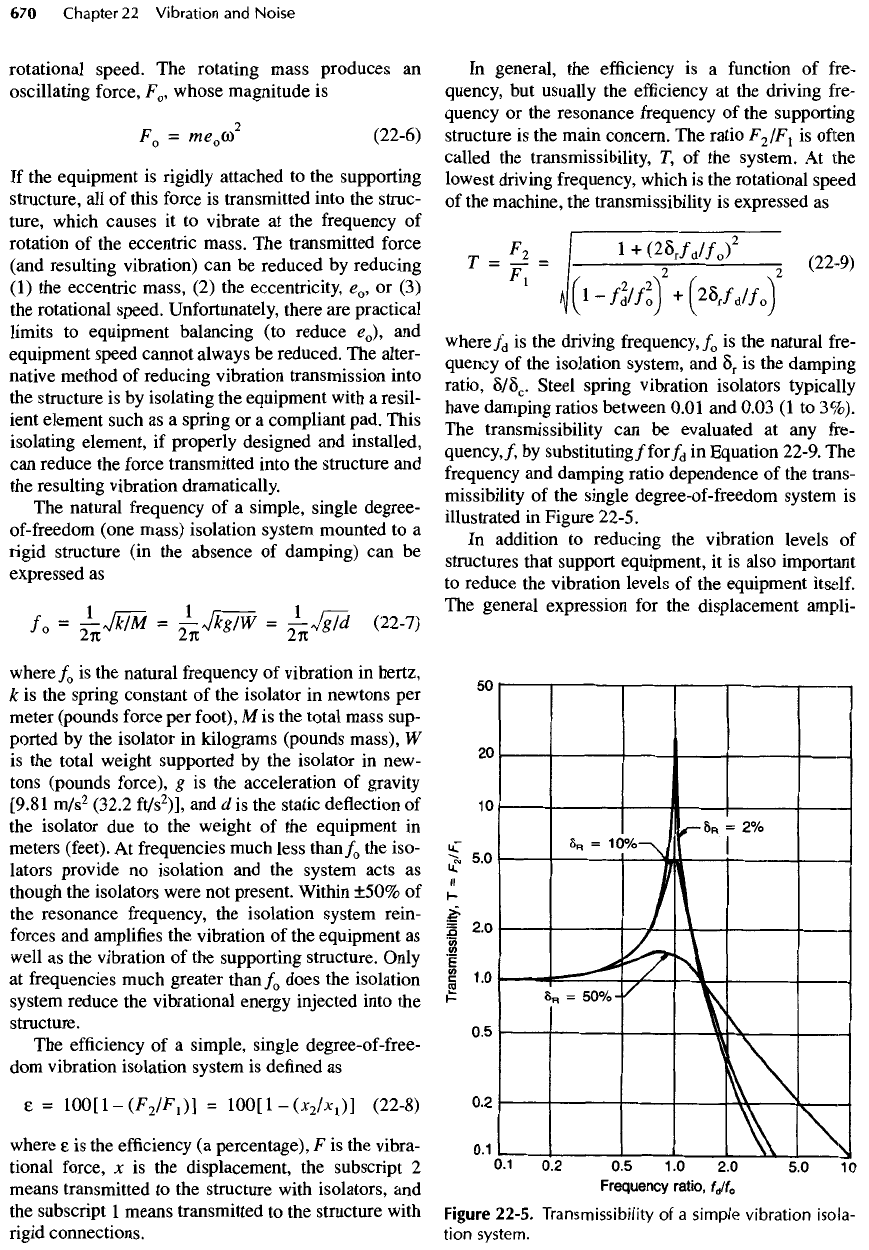
rotational speed.
The
rotating mass produces
an
oscillating force,
F
0
,
whose magnitude
is
F
0
=
me
0
co
2
(22-6)
If
the
equipment
is
rigidly attached
to the
supporting
structure,
all of
this force
is
transmitted into
the
struc-
ture,
which causes
it to
vibrate
at the
frequency
of
rotation
of the
eccentric
mass.
The
transmitted force
(and
resulting vibration)
can be
reduced
by
reducing
(1) the
eccentric mass,
(2) the
eccentricity,
e
Q9
or (3)
the
rotational speed. Unfortunately, there
are
practical
limits
to
equipment balancing
(to
reduce
^
0
),
and
equipment
speed
cannot always
be
reduced.
The
alter-
native
method
of
reducing vibration transmission into
the
structure
is by
isolating
the
equipment with
a
resil-
ient
element such
as a
spring
or a
compliant
pad.
This
isolating element,
if
properly
designed
and
installed,
can
reduce
the
force transmitted into
the
structure
and
the
resulting vibration dramatically.
The
natural frequency
of a
simple, single degree-
of-freedom
(one
mass) isolation system mounted
to a
rigid
structure
(in the
absence
of
damping)
can be
expressed
as
/„
=±JUM
=
±JWW
=
^JtTd
(22-1)
where
/
0
is the
natural frequency
of
vibration
in
hertz,
k
is the
spring constant
of the
isolator
in
newtons
per
meter (pounds force
per
foot),
M is the
total
mass
sup-
ported
by the
isolator
in
kilograms (pounds mass),
W
is
the
total weight supported
by the
isolator
in
new-
tons (pounds force),
g is the
acceleration
of
gravity
[9.81
m/s
2
(32.2
ft/s
2
)],
and d is the
static deflection
of
the
isolator
due to the
weight
of the
equipment
in
meters (feet).
At
frequencies much less
than/
0
the
iso-
lators provide
no
isolation
and the
system acts
as
though
the
isolators were
not
present. Within ±50%
of
the
resonance frequency,
the
isolation system rein-
forces
and
amplifies
the
vibration
of the
equipment
as
well
as the
vibration
of the
supporting structure. Only
at
frequencies much greater
than/
0
does
the
isolation
system
reduce
the
vibrational energy injected into
the
structure.
The
efficiency
of a
simple, single degree-of-free-
dom
vibration isolation system
is
defined
as
8
=
100[1-(F
2
AF
1
)]
=
100[1-(Jt
2
/*!)]
(22-8)
where
8 is the
efficiency
(a
percentage),
F is the
vibra-
tional
force,
x is the
displacement,
the
subscript
2
means
transmitted
to the
structure with isolators,
and
the
subscript
1
means transmitted
to the
structure with
rigid
connections.
In
general,
the
efficiency
is a
function
of
fre-
quency,
but
usually
the
efficiency
at the
driving
fre-
quency
or the
resonance frequency
of the
supporting
structure
is the
main concern.
The
ratio
F
2
/F
1
is
often
called
the
transmissibility,
T,
of the
system.
At the
lowest driving frequency, which
is the
rotational speed
of
the
machine,
the
transmissibility
is
expressed
as
r
=
;>=
i+w-//-)
2
2
(22
..
9)
1
^|(l-/d//o)
+(25
r
/
d
//
0
)
where
/
d
is the
driving
frequency,
/
0
is the
natural fre-
quency
of the
isolation
system,
and
S
1
.
is the
damping
ratio,
8/8
c
.
Steel spring vibration isolators typically
have
damping ratios between
0.01
and
0.03
(1 to
3%).
The
transmissibility
can be
evaluated
at any
fre-
quency,/,
by
substituting
/f
or
/
d
in
Equation
22-9.
The
frequency
and
damping ratio dependence
of the
trans-
missibility
of the
single
degree-of-freedom
system
is
illustrated
in
Figure
22-5.
In
addition
to
reducing
the
vibration levels
of
structures that support equipment,
it is
also
important
to
reduce
the
vibration
levels
of the
equipment
itself.
The
general expression
for the
displacement
ampli-
Figure
22-5.
Transmissibility
of a
simple
vibration
isola-
tion
system.
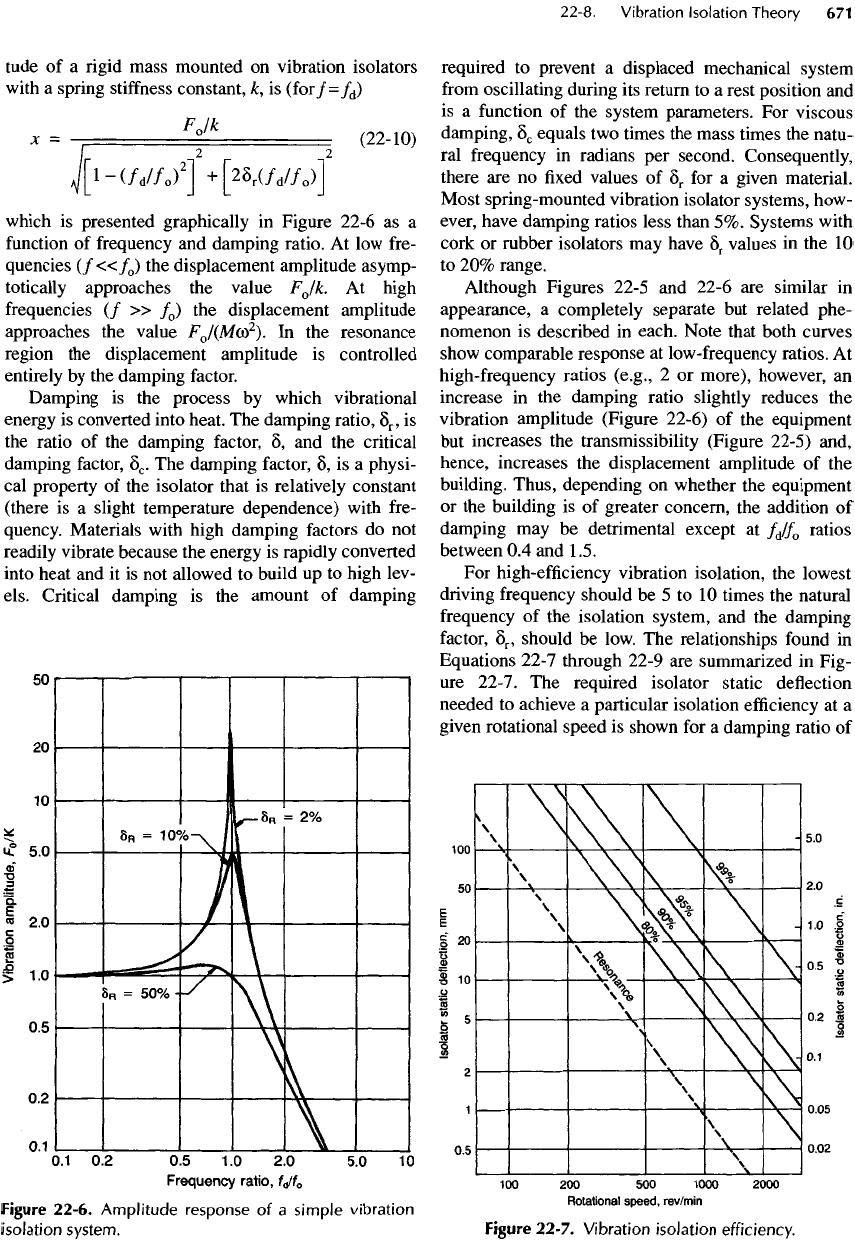
tude
of a
rigid mass mounted
on
vibration isolators
with
a
spring
stiffness
constant,
k, is
(for/=/
d
)
"
)
T
<22
-"»
j[l-(/d//o)
2
]
+[25,(/a//o>]
which
is
presented graphically
in
Figure 22-6
as a
function
of
frequency
and
damping ratio.
At low
fre-
quencies
(/«/
0
)
the
displacement amplitude asymp-
totically
approaches
the
value FJk.
At
high
frequencies
(/
»
/
0
)
the
displacement amplitude
approaches
the
value
F
0
/(Moo
2
).
In the
resonance
region
the
displacement amplitude
is
controlled
entirely
by the
damping factor.
Damping
is the
process
by
which vibrational
energy
is
converted into heat.
The
damping ratio,
8
r
,
is
the
ratio
of the
damping
factor,
8, and the
critical
damping factor,
8
C
.
The
damping factor,
8, is a
physi-
cal
property
of the
isolator that
is
relatively constant
(there
is a
slight temperature dependence) with fre-
quency.
Materials with high damping factors
do not
readily vibrate because
the
energy
is
rapidly converted
into
heat
and it is not
allowed
to
build
up to
high lev-
els. Critical damping
is the
amount
of
damping
Figure
22-6.
Amplitude
response
of a
simple vibration
isolation
system.
required
to
prevent
a
displaced mechanical system
from
oscillating during
its
return
to a
rest position
and
is a
function
of the
system
parameters.
For
viscous
damping,
8
C
equals
two
times
the
mass times
the
natu-
ral
frequency
in
radians
per
second. Consequently,
there
are no fixed
values
of
8
r
for a
given material.
Most spring-mounted vibration
isolator
systems, how-
ever, have damping ratios less than
5%.
Systems with
cork
or
rubber isolators
may
have
8
r
values
in the 10
to
20%
range.
Although
Figures
22-5
and
22-6
are
similar
in
appearance,
a
completely separate
but
related phe-
nomenon
is
described
in
each. Note that both curves
show
comparable response
at
low-frequency ratios.
At
high-frequency
ratios
(e.g.,
2 or
more), however,
an
increase
in the
damping ratio slightly reduces
the
vibration
amplitude (Figure 22-6)
of the
equipment
but
increases
the
transmissibility (Figure 22-5) and,
hence,
increases
the
displacement
amplitude
of the
building. Thus, depending
on
whether
the
equipment
or
the
building
is of
greater concern,
the
addition
of
damping
may be
detrimental except
at
f
d
/f
0
ratios
between
0.4 and
1.5.
For
high-efficiency
vibration isolation,
the
lowest
driving
frequency
should
be 5 to 10
times
the
natural
frequency
of the
isolation system,
and the
damping
factor,
8
r
,
should
be
low.
The
relationships
found
in
Equations 22-7 through 22-9
are
summarized
in
Fig-
ure
22-7.
The
required isolator static
deflection
needed
to
achieve
a
particular isolation
efficiency
at a
given
rotational speed
is
shown
for a
damping ratio
of
Figure
22-7.
Vibration
isolation
efficiency.
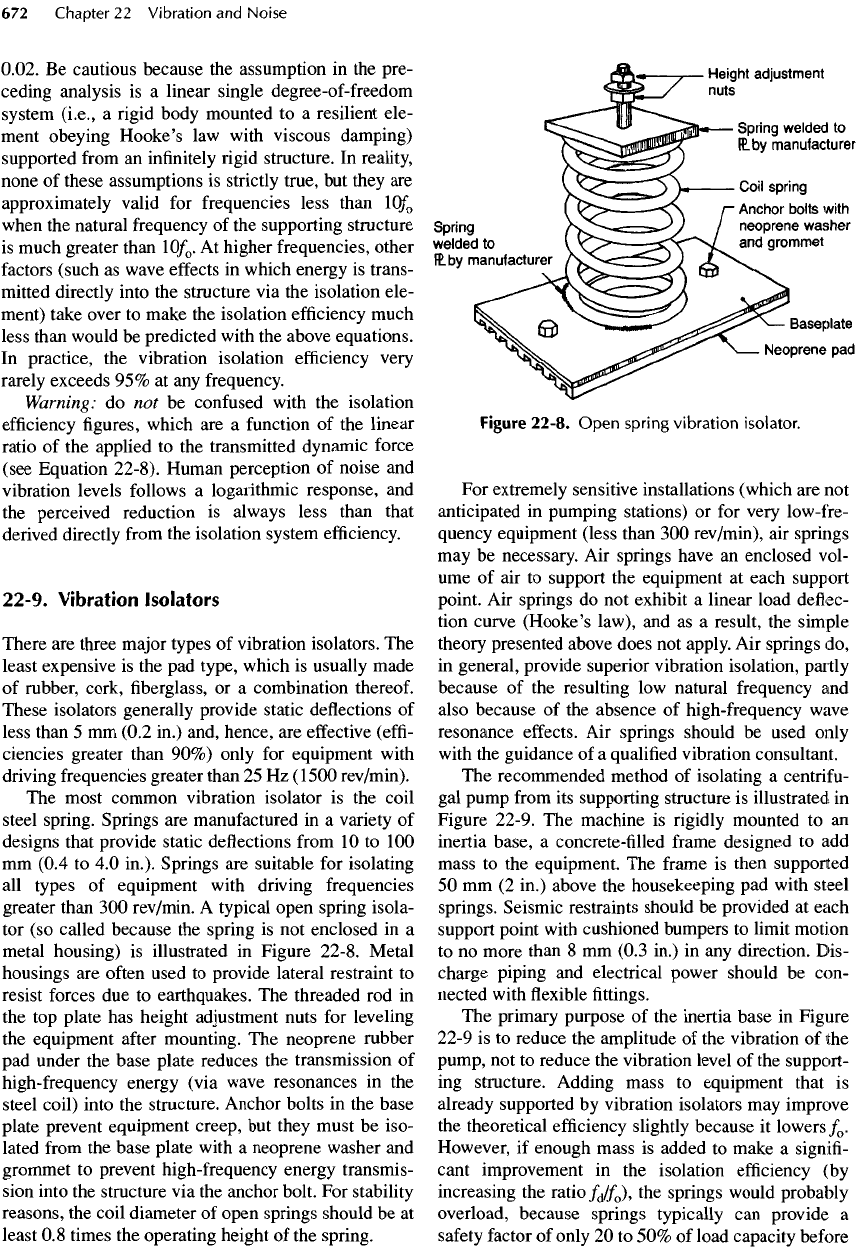
0.02.
Be
cautious because
the
assumption
in the
pre-
ceding analysis
is a
linear single degree-of-freedom
system
(i.e.,
a
rigid body mounted
to a
resilient
ele-
ment
obeying
Hooke's
law
with viscous damping)
supported
from
an
infinitely
rigid structure.
In
reality,
none
of
these
assumptions
is
strictly true,
but
they
are
approximately valid
for
frequencies less than
10/
0
when
the
natural
frequency
of the
supporting structure
is
much greater than
10/
0
.
At
higher frequencies, other
factors
(such
as
wave
effects
in
which energy
is
trans-
mitted
directly into
the
structure
via the
isolation ele-
ment)
take over
to
make
the
isolation
efficiency
much
less than would
be
predicted with
the
above equations.
In
practice,
the
vibration isolation
efficiency
very
rarely exceeds
95% at any
frequency.
Warning:
do not be
confused
with
the
isolation
efficiency
figures,
which
are a
function
of the
linear
ratio
of the
applied
to the
transmitted dynamic force
(see Equation 22-8). Human perception
of
noise
and
vibration levels follows
a
logarithmic response,
and
the
perceived reduction
is
always less than that
derived directly
from
the
isolation system
efficiency.
22-9.
Vibration
Isolators
There
are
three
major
types
of
vibration isolators.
The
least expensive
is the pad
type, which
is
usually made
of
rubber, cork,
fiberglass, or a
combination thereof.
These isolators generally provide static deflections
of
less than
5 mm
(0.2 in.) and,
hence,
are
effective
(effi-
ciencies greater than 90%) only
for
equipment with
driving
frequencies greater than
25 Hz
(1500
rev/min).
The
most common vibration isolator
is the
coil
steel spring. Springs
are
manufactured
in a
variety
of
designs that provide static deflections
from
10 to 100
mm
(0.4
to 4.0
in.).
Springs
are
suitable
for
isolating
all
types
of
equipment with driving frequencies
greater than
300
rev/min.
A
typical open spring
isola-
tor
(so
called because
the
spring
is not
enclosed
in a
metal housing)
is
illustrated
in
Figure 22-8. Metal
housings
are
often
used
to
provide lateral restraint
to
resist forces
due to
earthquakes.
The
threaded
rod in
the top
plate
has
height adjustment nuts
for
leveling
the
equipment
after
mounting.
The
neoprene
rubber
pad
under
the
base plate reduces
the
transmission
of
high-frequency
energy (via wave resonances
in the
steel coil) into
the
structure. Anchor bolts
in the
base
plate prevent equipment
creep,
but
they must
be
iso-
lated
from
the
base
plate with
a
neoprene washer
and
grommet
to
prevent high-frequency energy transmis-
sion
into
the
structure
via the
anchor bolt.
For
stability
reasons,
the
coil
diameter
of
open springs should
be at
least
0.8
times
the
operating height
of the
spring.
Figure
22-8.
Open
spring vibration isolator.
For
extremely sensitive installations (which
are not
anticipated
in
pumping stations)
or for
very
low-fre-
quency equipment (less than
300
rev/min),
air
springs
may
be
necessary.
Air
springs have
an
enclosed
vol-
ume of air to
support
the
equipment
at
each support
point.
Air
springs
do not
exhibit
a
linear load
deflec-
tion curve
(Hooke's
law),
and as a
result,
the
simple
theory presented above does
not
apply.
Air
springs
do,
in
general, provide superior vibration isolation,
partly
because
of the
resulting
low
natural frequency
and
also because
of the
absence
of
high-frequency wave
resonance
effects.
Air
springs should
be
used only
with
the
guidance
of a
qualified
vibration consultant.
The
recommended method
of
isolating
a
centrifu-
gal
pump
from
its
supporting structure
is
illustrated
in
Figure 22-9.
The
machine
is
rigidly mounted
to an
inertia
base,
a
concrete-filled
frame
designed
to add
mass
to the
equipment.
The
frame
is
then supported
50 mm (2
in.) above
the
housekeeping
pad
with steel
springs. Seismic restraints should
be
provided
at
each
support point with cushioned bumpers
to
limit
moti
on
to no
more than
8 mm
(0.3 in.)
in any
direction.
Dis-
charge piping
and
electrical
power should
be
con-
nected with
flexible fittings.
The
primary purpose
of the
inertia base
in
Figure
22-9
is to
reduce
the
amplitude
of the
vibration
of the
pump,
not to
reduce
the
vibration level
of the
support-
ing
structure. Adding mass
to
equipment that
is
already supported
by
vibration isolators
may
improve
the
theoretical
efficiency
slightly because
it
lowers
/
0
.
However,
if
enough mass
is
added
to
make
a
signifi-
cant improvement
in the
isolation
efficiency
(by
increasing
the
ratio
/
d
//
0
),
the
springs would probably
overload,
because
springs typically
can
provide
a
safety
factor
of
only
20 to 50% of
load capacity before
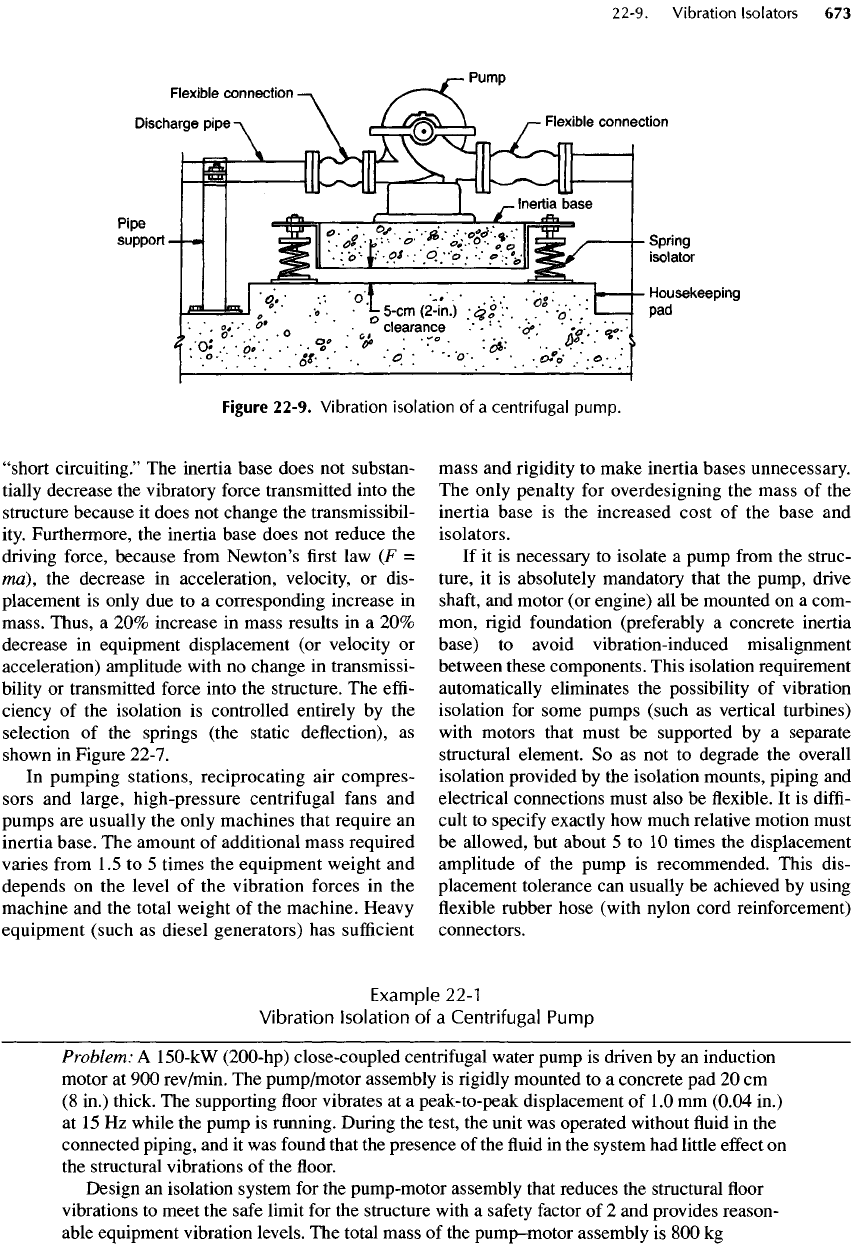
"short
circuiting."
The
inertia base does
not
substan-
tially
decrease
the
vibratory force transmitted into
the
structure
because
it
does
not
change
the
transmissibil-
ity.
Furthermore,
the
inertia base does
not
reduce
the
driving
force, because
from
Newton's
first law (F =
ma),
the
decrease
in
acceleration, velocity,
or
dis-
placement
is
only
due to a
corresponding
increase
in
mass.
Thus,
a 20%
increase
in
mass results
in a 20%
decrease
in
equipment displacement
(or
velocity
or
acceleration) amplitude with
no
change
in
transmissi-
bility
or
transmitted force into
the
structure.
The
effi-
ciency
of the
isolation
is
controlled entirely
by the
selection
of the
springs (the static deflection),
as
shown
in
Figure 22-7.
In
pumping stations, reciprocating
air
compres-
sors
and
large, high-pressure centrifugal
fans
and
pumps
are
usually
the
only machines that require
an
inertia
base.
The
amount
of
additional
mass
required
varies
from
1
.5
to 5
times
the
equipment weight
and
depends
on the
level
of the
vibration forces
in the
machine
and the
total weight
of the
machine. Heavy
equipment
(such
as
diesel generators)
has
sufficient
mass
and rigidity to
make inertia bases unnecessary.
The
only penalty
for
overdesigning
the
mass
of the
inertia base
is the
increased cost
of the
base
and
isolators.
If
it is
necessary
to
isolate
a
pump
from
the
struc-
ture,
it is
absolutely mandatory that
the
pump, drive
shaft,
and
motor
(or
engine)
all be
mounted
on a
com-
mon, rigid foundation (preferably
a
concrete inertia
base)
to
avoid vibration-induced misalignment
between these components. This isolation requirement
automatically eliminates
the
possibility
of
vibration
isolation
for
some pumps (such
as
vertical turbines)
with
motors that must
be
supported
by a
separate
structural
element.
So as not to
degrade
the
overall
isolation provided
by the
isolation mounts, piping
and
electrical connections must also
be flexible. It is
diffi-
cult
to
specify
exactly
how
much relative motion must
be
allowed,
but
about
5 to 10
times
the
displacement
amplitude
of the
pump
is
recommended. This dis-
placement tolerance
can
usually
be
achieved
by
using
flexible
rubber hose (with nylon cord reinforcement)
connectors.
Figure
22-9.
Vibration
isolation
of a
centrifugal
pump.
Example
22-1
Vibration
Isolation
of a
Centrifugal Pump
Problem:
A
150-kW
(200-hp)
close-coupled centrifugal water pump
is
driven
by an
induction
motor
at 900
rev/min.
The
pump/motor assembly
is
rigidly mounted
to a
concrete
pad 20 cm
(8
in.) thick.
The
supporting
floor
vibrates
at a
peak-to-peak displacement
of 1.0 mm
(0.04 in.)
at
15 Hz
while
the
pump
is
running. During
the
test,
the
unit
was
operated without
fluid in the
connected piping,
and it was
found
that
the
presence
of the fluid in the
system
had
little
effect
on
the
structural vibrations
of the floor.
Design
an
isolation
system
for the
pump-motor assembly that
reduces
the
structural
floor
vibrations
to
meet
the
safe
limit
for the
structure with
a
safety
factor
of 2 and
provides reason-
able equipment vibration levels.
The
total mass
of the
pump-motor
assembly
is 800 kg
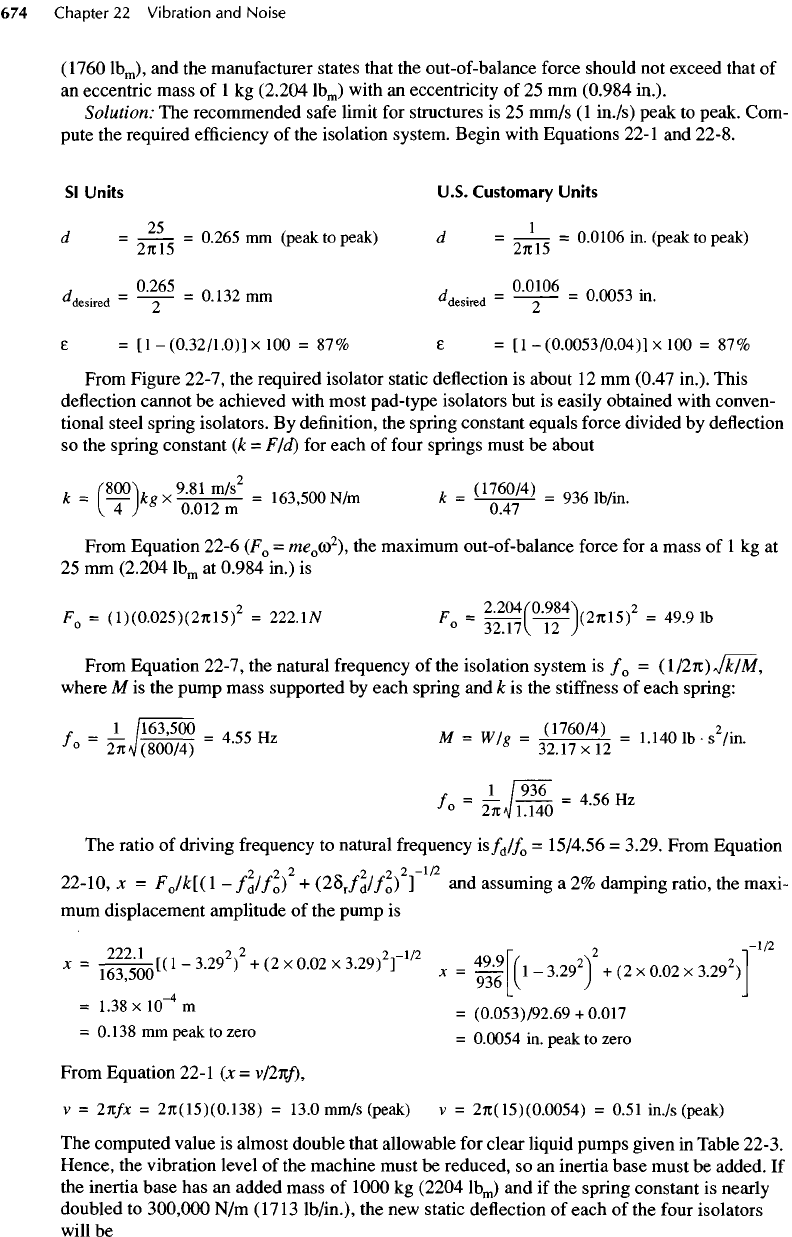
(1760
lb
m
),
and the
manufacturer states that
the
out-of-balance
force should
not
exceed that
of
an
eccentric mass
of 1 kg
(2.204
lb
m
)
with
an
eccentricity
of 25 mm
(0.984
in.).
Solution:
The
recommended
safe
limit
for
structures
is 25
mm/s
(1
in./s)
peak
to
peak. Com-
pute
the
required
efficiency
of the
isolation system. Begin with Equations
22-1
and
22-8.
Sl
Units
U.S. Customary
Units
d
=
-——
=
0.265
mm
(peak
to
peak)
d =
-——
=
0.0106
in.
(peak
to
peak)
27tl5
27il5
**««,
=
9
T
5
=
°'
132
mm
Desired
=
^
=
0.0053
in.
e
= [1 -
(0.32/1.O)]
x 100 = 87% 8
=
[1 -
(0.0053/0.04)]
x 100 = 87%
From Figure 22-7,
the
required isolator static deflection
is
about
12 mm
(0.47
in.).
This
deflection
cannot
be
achieved with most pad-type isolators
but is
easily obtained with conven-
tional steel spring isolators.
By
definition,
the
spring constant equals force divided
by
deflection
so the
spring constant
(k =
FId)
for
each
of
four
springs must
be
about
.
fSOOV
9.81
m/s
2
^0«™^/
,
(1760/4)
fta
,
1U/
.
*
=
ITJ**
x
0012^
=
163
'
500
N/m
*
=
-^r
=
936
lb/m
-
From Equation 22-6
(F
0
=
W^
0
GO
2
),
the
maximum out-of-balance force
for a
mass
of 1 kg at
25
mm
(2.204
Ib
1n
at
0.984
in.)
is
F
0
=
(I)(0.025)(27il5)
2
=
222.1N
F
0
=
||gpg^(27ul5)
2
=
49.9
Ib
From Equation 22-7,
the
natural frequency
of the
isolation system
is
/
0
=
(l/2n)*/k/M
9
where
M is the
pump mass supported
by
each spring
and k is the
stiffness
of
each spring:
,
1
/163,500
.
«
TT
„
TI//
(1760/4)
11/1A1U
2..
'°
=
2~n
J(800/4)
=
4
'
55
HZ
M =
WIg
=
£_£
=
1.140
Ib
-
s
/in.
,
1 /
936
.
-,
„
^
=
aWruo
=
4
-
56Hz
The
ratio
of
driving frequency
to
natural
frequency
is/
d
//
0
=
15/4.56
=
3.29.
From Equation
22-10,
x =
F
0
Mf(I
-
/d//o)
2
+
(28
r
/d//o)V
1/2
and
assuming
a 2%
damping ratio,
the
maxi-
mum
displacement amplitude
of the
pump
is
*
=
if^o[(l-3.29
2
)
2
+
(2x0.02x3.29)
2
r
1/2
x
=
||^
_^
+
(2xOQ2
^.^J""
2
_4
LJ
=
1.38
x 10 m
=
(
0
.053)/92.69
+
0.017
=
0.138
mm
peak
to
zero
=
0
0054
in
peak
to
zero
From Equation
22-1
(x =
v/2nf),
v
=
2nfx
=
2n(15)(0.138)
=
13.0
mm/s (peak)
v =
27i(15)(0.0054)
=
0.51 in./s
(peak)
The
computed value
is
almost double that allowable
for
clear liquid pumps given
in
Table
22-3.
Hence,
the
vibration level
of the
machine must
be
reduced,
so an
inertia base must
be
added.
If
the
inertia base
has an
added mass
of
1000
kg
(2204
lb
m
)
and if the
spring constant
is
nearly
doubled
to
300,000
N/m
(1713
lb/in.),
the new
static deflection
of
each
of the
four
isolators
will
be
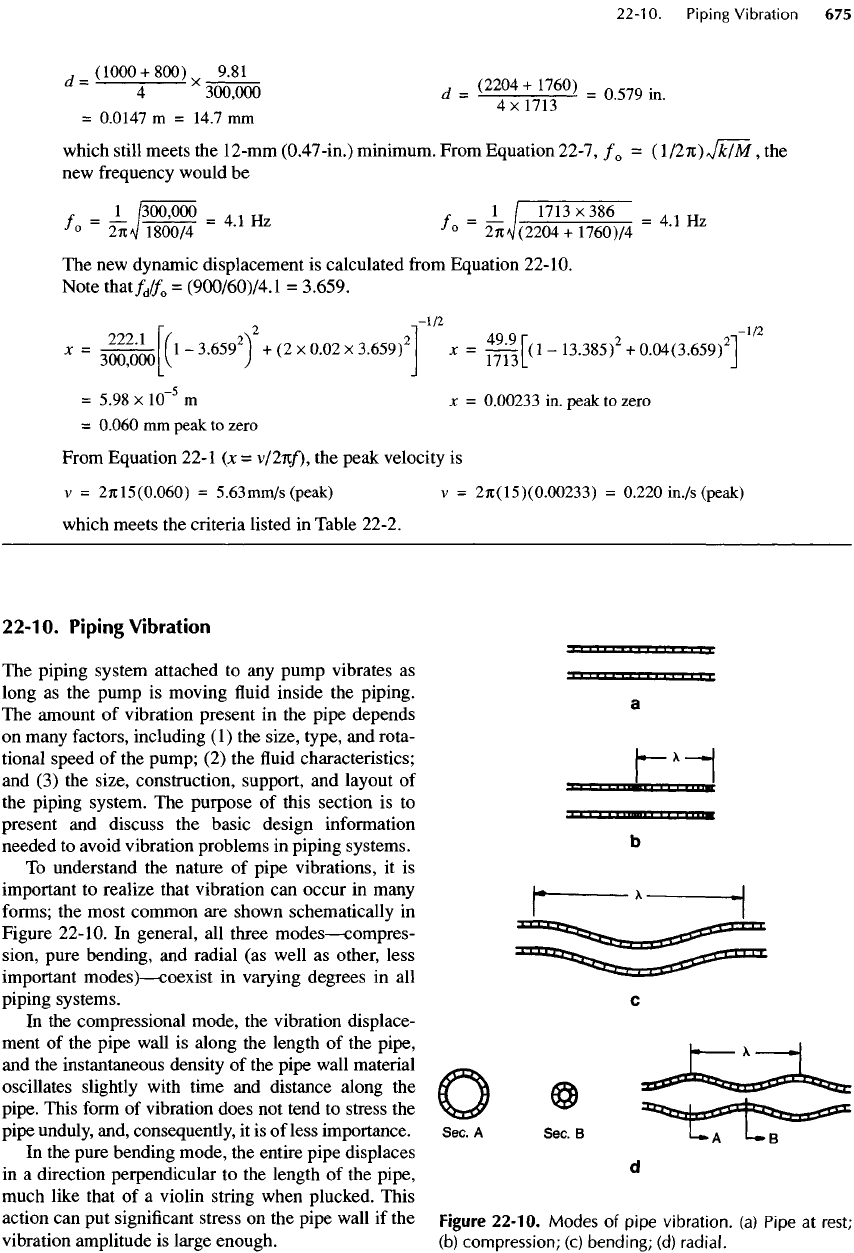
22-10.
Piping
Vibration
The
piping system attached
to any
pump vibrates
as
long
as the
pump
is
moving
fluid
inside
the
piping.
The
amount
of
vibration present
in the
pipe
depends
on
many factors, including
(1)
the
size, type,
and
rota-
tional
speed
of the
pump;
(2) the fluid
characteristics;
and (3) the
size, construction, support,
and
layout
of
the
piping system.
The
purpose
of
this
section
is to
present
and
discuss
the
basic design information
needed
to
avoid vibration problems
in
piping systems.
To
understand
the
nature
of
pipe vibrations,
it is
important
to
realize that vibration
can
occur
in
many
forms;
the
most common
are
shown schematically
in
Figure 22-10.
In
general,
all
three
modes
—
compres-
sion, pure bending,
and
radial
(as
well
as
other, less
important
modes)
—
coexist
in
varying degrees
in all
piping systems.
In
the
compressional mode,
the
vibration displace-
ment
of the
pipe wall
is
along
the
length
of the
pipe,
and
the
instantaneous density
of the
pipe wall material
oscillates slightly with time
and
distance along
the
pipe. This
form
of
vibration does
not
tend
to
stress
the
pipe
unduly,
and, consequently,
it is of
less importance.
In
the
pure bending mode,
the
entire pipe displaces
in
a
direction perpendicular
to the
length
of the
pipe,
much
like
that
of a
violin string when plucked.
This
action
can put
significant
stress
on the
pipe wall
if the
vibration
amplitude
is
large enough.
Figure
22-10.
Modes
of
pipe
vibration,
(a)
Pipe
at
rest;
(b)
compression;
(c)
bending;
(d)
radial.
,
(1000
+
800)
9.81
d
=
4
*
300^00
d
=
(^I^Q)
=
0<579in<
=
0.0147
m =
14.7
mm
which
still meets
the
12-mm
(0.47-in.)
minimum. From Equation 22-7,
/
0
=
(l/2n)Jk/M,
the
new
frequency
would
be
=
J_
/300,000
=
41
TT
f
=
JL /
1713x386""
/0
27TA/1800/4
Z
/0
271V
(2204+1760)74
The new
dynamic displacement
is
calculated
from
Equation
22-10.
Note
that/
d
//
0
=
(900/60)/4.1
=
3.659.
*
=
5TOoK
1-3
'
6592
)
+
(
2x
°-
02x3
-
659
)
2
*
=
Yyj|[(l-13.385)
2
+
0.04(3.659)
2
]
=
5.98
x
10~
5
m x =
0.00233
in.
peak
to
zero
=
0.060
mm
peak
to
zero
From Equation
22-1
(jc
=
v/2n/),
the
peak velocity
is
v
=
27115(0.060)
=
5.63mm/s
(peak)
v
=
27t(
15)(0.00233)
=
0.220
in./s
(peak)
which
meets
the
criteria listed
in
Table 22-2.
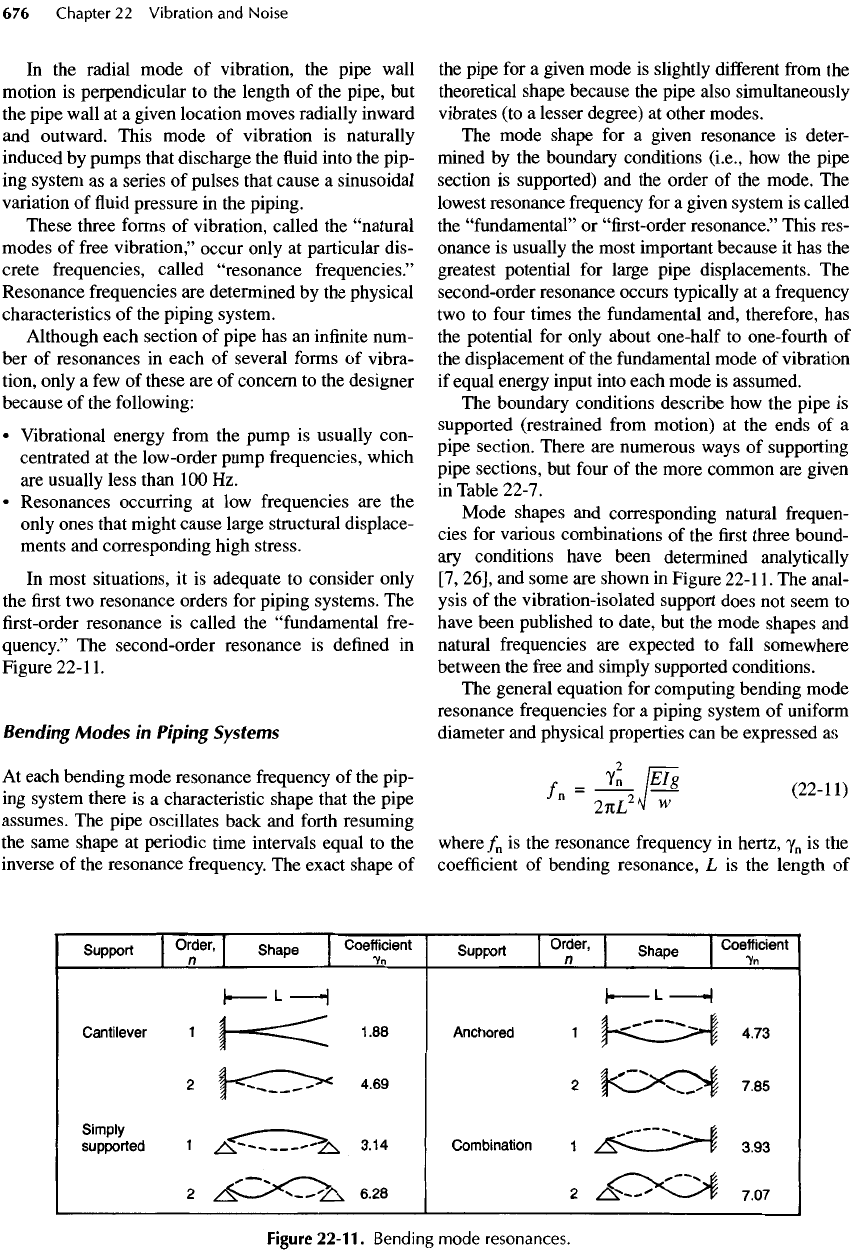
In
the
radial mode
of
vibration,
the
pipe
wall
motion
is
perpendicular
to the
length
of the
pipe,
but
the
pipe wall
at a
given location moves radially inward
and
outward. This mode
of
vibration
is
naturally
induced
by
pumps that discharge
the fluid
into
the
pip-
ing
system
as a
series
of
pulses that cause
a
sinusoidal
variation
of fluid
pressure
in the
piping.
These three
forms
of
vibration, called
the
"natural
modes
of
free
vibration," occur only
at
particular
dis-
crete frequencies, called
"resonance
frequencies."
Resonance frequencies
are
determined
by the
physical
characteristics
of the
piping system.
Although
each section
of
pipe
has an
infinite
num-
ber of
resonances
in
each
of
several forms
of
vibra-
tion,
only
a few of
these
are of
concern
to the
designer
because
of the
following:
•
Vibrational energy
from
the
pump
is
usually
con-
centrated
at the
low-order pump frequencies, which
are
usually less than
100 Hz.
•
Resonances occurring
at low
frequencies
are the
only
ones that might cause large structural displace-
ments
and
corresponding high stress.
In
most situations,
it is
adequate
to
consider only
the first two
resonance orders
for
piping systems.
The
first-order
resonance
is
called
the
"fundamental
fre-
quency."
The
second-order resonance
is
defined
in
Figure
22-11.
Bending
Modes
in
Piping
Systems
At
each bending mode resonance
frequency
of the
pip-
ing
system there
is a
characteristic shape that
the
pipe
assumes.
The
pipe oscillates back
and
forth
resuming
the
same shape
at
periodic
time intervals
equal
to the
inverse
of the
resonance
frequency.
The
exact shape
of
the
pipe
for a
given mode
is
slightly
different
from
the
theoretical shape because
the
pipe also simultaneously
vibrates
(to a
lesser degree)
at
other modes.
The
mode shape
for a
given resonance
is
deter-
mined
by the
boundary
conditions
(i.e.,
how the
pipe
section
is
supported)
and the
order
of the
mode.
The
lowest resonance
frequency
for a
given system
is
called
the
"fundamental"
or
"first-order
resonance."
This
res-
onance
is
usually
the
most important because
it has the
greatest potential
for
large pipe displacements.
The
second-order resonance occurs typically
at a
frequency
two to
four
times
the
fundamental
and,
therefore,
has
the
potential
for
only about one-half
to
one-fourth
of
the
displacement
of the
fundamental mode
of
vibration
if
equal energy input into each mode
is
assumed.
The
boundary conditions describe
how the
pipe
is
supported (restrained
from
motion)
at the
ends
of a
pipe section. There
are
numerous ways
of
supporting
pipe sections,
but
four
of the
more common
are
given
in
Table 22-7.
Mode shapes
and
corresponding natural
frequen-
cies
for
various combinations
of the first
three bound-
ary
conditions have been determined analytically
[7,
26],
and
some
are
shown
in
Figure
22-1
1.
The
anal-
ysis
of the
vibration-isolated support does
not
seem
to
have
been published
to
date,
but the
mode shapes
and
natural
frequencies
are
expected
to
fall
somewhere
between
the
free
and
simply supported conditions.
The
general equation
for
computing bending mode
resonance frequencies
for a
piping system
of
uniform
diameter
and
physical
properties
can be
expressed
as
/„=
Yn
ps
(22-11)
2TiL
2
V
w
where
/
n
is the
resonance
frequency
in
hertz,
y
n
is the
coefficient
of
bending
resonance,
L is the
length
of
Figure
22-11.
Bending mode
resonances.
Support
I
0«ter,
I
^
I
Coefficient
I
Support
I
Order,
I
~I
Coefficient
H
J
rn
j
n Yn
Anchored
1
2
Combination
1
2
Cantilever
1
2
Simply
supported
1
2
4.73
7.85
3.93
7.07
1.88
4.69
3.14
6.28
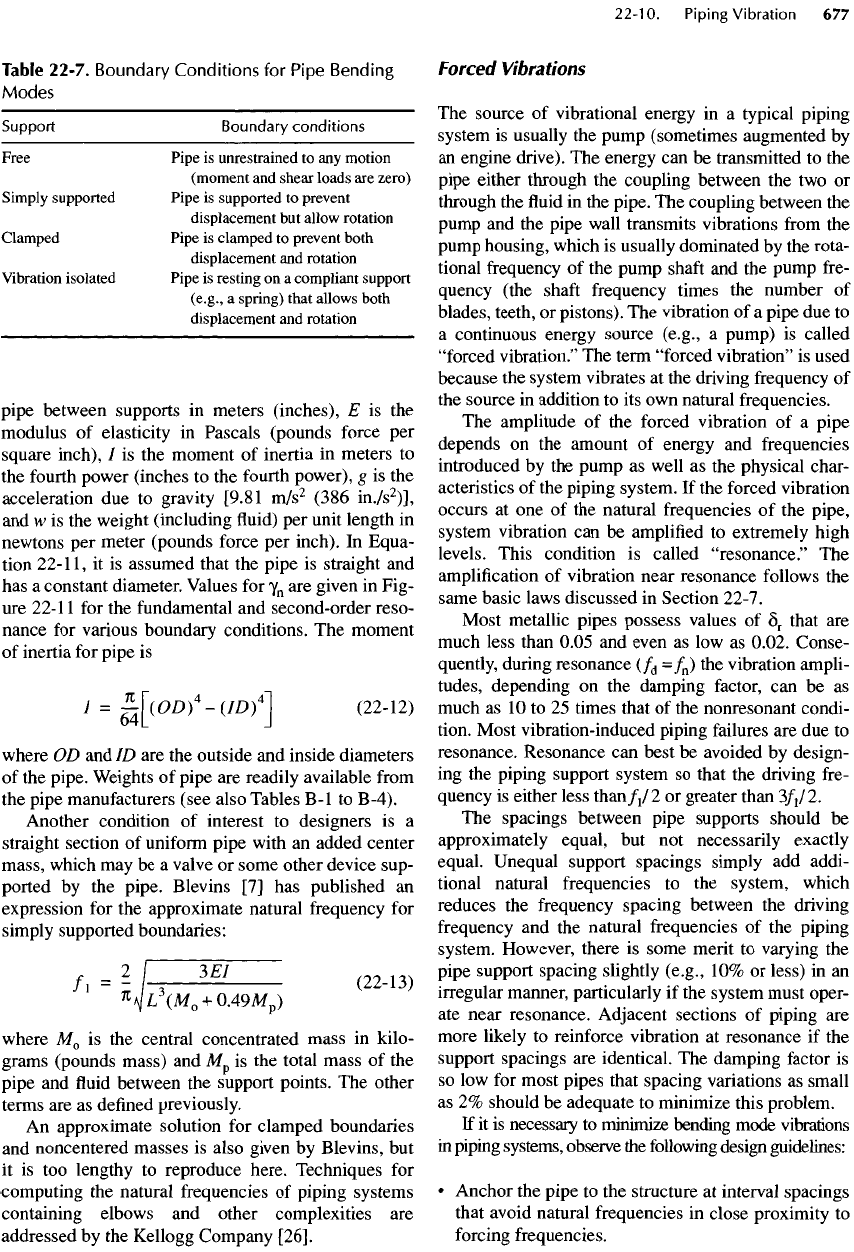
Table
22-7.
Boundary
Conditions
for
Pipe
Bending
Modes
Support
Boundary
conditions
Free
Pipe
is
unrestrained
to any
motion
(moment
and
shear
loads
are
zero)
Simply supported
Pipe
is
supported
to
prevent
displacement
but
allow rotation
Clamped
Pipe
is
clamped
to
prevent both
displacement
and
rotation
Vibration isolated
Pipe
is
resting
on a
compliant support
(e.g.,
a
spring) that allows
both
displacement
and
rotation
pipe between supports
in
meters (inches),
E is the
modulus
of
elasticity
in
Pascals (pounds force
per
square inch),
/ is the
moment
of
inertia
in
meters
to
the
fourth
power (inches
to the
fourth
power),
g is the
acceleration
due to
gravity
[9.81 m/s
2
(386
in./s
2
)],
and
w
is the
weight (including
fluid) per
unit length
in
newtons
per
meter (pounds force
per
inch).
In
Equa-
tion
22-11,
it is
assumed that
the
pipe
is
straight
and
has a
constant diameter. Values
for
y
n
are
given
in
Fig-
ure
22-1
1
for the
fundamental
and
second-order reso-
nance
for
various boundary conditions.
The
moment
of
inertia
for
pipe
is
/ =
^[(OD)
4
-(/Z))
4
]
(22-12)
where
OD and ID are the
outside
and
inside diameters
of
the
pipe. Weights
of
pipe
are
readily available
from
the
pipe manufacturers (see
also
Tables
B-I
to
B-4).
Another condition
of
interest
to
designers
is a
straight section
of
uniform
pipe with
an
added center
mass, which
may be a
valve
or
some other device sup-
ported
by the
pipe. Blevins
[7] has
published
an
expression
for the
approximate natural
frequency
for
simply
supported boundaries:
/i
=
;
/-
—
(22-13)
^
A/
L
(M
0
+
0.49
M
p
)
where
M
0
is the
central concentrated mass
in
kilo-
grams (pounds mass)
and
M
p
is the
total mass
of the
pipe
and fluid
between
the
support points.
The
other
terms
are as
defined previously.
An
approximate solution
for
clamped boundaries
and
noncentered masses
is
also given
by
Blevins,
but
it
is too
lengthy
to
reproduce here. Techniques
for
computing
the
natural frequencies
of
piping systems
containing elbows
and
other complexities
are
addressed
by the
Kellogg Company
[26].
Forced Vibrations
The
source
of
vibrational energy
in a
typical piping
system
is
usually
the
pump (sometimes augmented
by
an
engine drive).
The
energy
can be
transmitted
to the
pipe either through
the
coupling between
the two or
through
the fluid in the
pipe.
The
coupling between
the
pump
and the
pipe
wall transmits vibrations
from
the
pump
housing, which
is
usually dominated
by the
rota-
tional
frequency
of the
pump
shaft
and the
pump fre-
quency
(the
shaft
frequency times
the
number
of
blades, teeth,
or
pistons).
The
vibration
of a
pipe
due to
a
continuous energy source (e.g.,
a
pump)
is
called
"forced
vibration."
The
term "forced vibration"
is
used
because
the
system vibrates
at the
driving
frequency
of
the
source
in
addition
to its own
natural frequencies.
The
amplitude
of the
forced vibration
of a
pipe
depends
on the
amount
of
energy
and
frequencies
introduced
by the
pump
as
well
as the
physical char-
acteristics
of the
piping system.
If the
forced vibration
occurs
at one of the
natural frequencies
of the
pipe,
system vibration
can be
amplified
to
extremely high
levels.
This
condition
is
called
"resonance."
The
amplification
of
vibration near resonance follows
the
same basic laws discussed
in
Section 22-7.
Most metallic pipes possess values
of
8
r
that
are
much less than
0.05
and
even
as low as
0.02.
Conse-
quently,
during resonance
(/
d
=/
n
)
the
vibration ampli-
tudes, depending
on the
damping
factor,
can be as
much
as 10 to 25
times that
of the
nonresonant condi-
tion.
Most vibration-induced piping failures
are due to
resonance. Resonance
can
best
be
avoided
by
design-
ing the
piping support system
so
that
the
driving fre-
quency
is
either
less
than
J
1
/
2
or
greater than
3/j/2.
The
spacings between pipe supports should
be
approximately equal,
but not
necessarily exactly
equal. Unequal support spacings simply
add
addi-
tional natural frequencies
to the
system, which
reduces
the
frequency
spacing between
the
driving
frequency
and the
natural frequencies
of the
piping
system. However, there
is
some merit
to
varying
the
pipe
support spacing slightly (e.g.,
10% or
less)
in an
irregular manner, particularly
if the
system must oper-
ate
near resonance. Adjacent sections
of
piping
are
more likely
to
reinforce vibration
at
resonance
if the
support spacings
are
identical.
The
damping
factor
is
so
low for
most pipes that spacing variations
as
small
as
2%
should
be
adequate
to
minimize this problem.
If
it is
necessary
to
minimize bending mode vibrations
in
piping systems, observe
the
following design
guidelines:
•
Anchor
the
pipe
to the
structure
at
interval spacings
that avoid natural frequencies
in
close proximity
to
forcing
frequencies.
